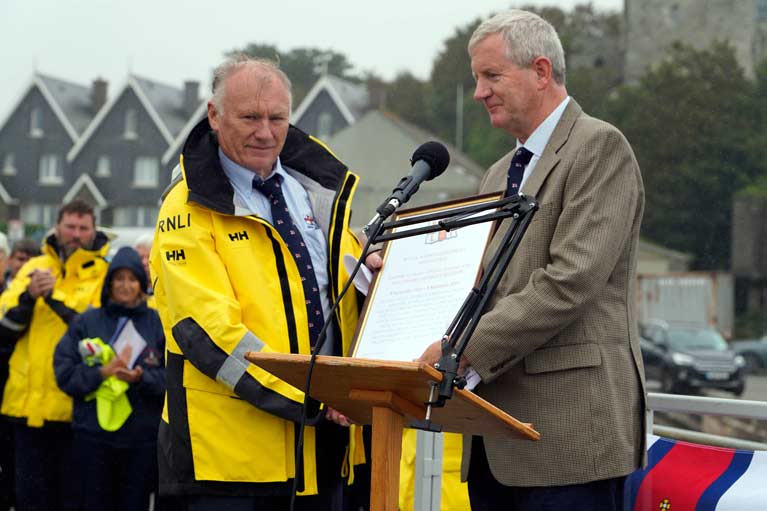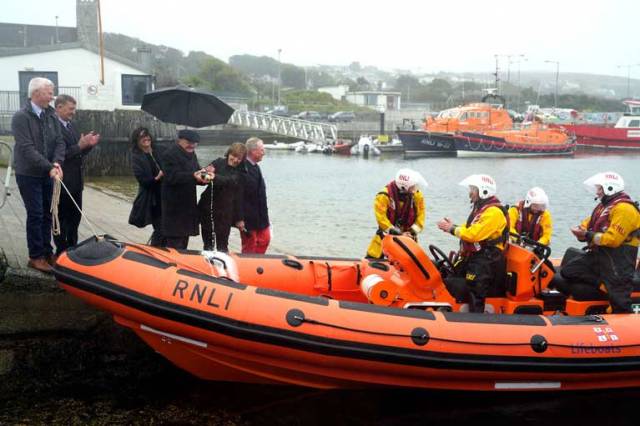Baltimore RNLI held a special ceremony on the North Pier yesterday which saw the station receive a Vellum (Inscription of thanks from the Institution) marking one hundred years of saving lives at sea and the naming the new Atlantic 85 lifeboat Rita Daphne Smyth. Crowds turned out to witness the occasion and acknowledge the service of the men and women who throughout the last ten decades have seen Baltimore RNLI launched 940 times and rescue 867 people.
The new lifeboat was officially named exactly 100 years on from the day the first lifeboat The Shamrock, arrived in the West Cork coastal village. It will work alongside the station’s All-Weather Tamar lifeboat, Alan Massey. The new inshore lifeboat has been funded by a generous legacy from the late Rita Daphne Smyth and replaces the station’s Atlantic 75 class lifeboat Alice and Charles.
 Coxswain Kieran Cotter receiving the station vellum from RNLI Council member Hugh Tully
Coxswain Kieran Cotter receiving the station vellum from RNLI Council member Hugh Tully
The Atlantic 85 is powered by two 115 horsepower engines and has a stronger hull and greater top speed than her predecessor. The added radar allows the crew to operate more effectively in poor visibility and she also has VHF direction-finding equipment. The vessel also has a manually operated self-righting mechanism which combined with inversion-proofed engines, keep the lifeboat operational even after capsizing. The lifeboat can also be beached in an emergency without causing damage to its engines or steering gear.
During the ceremony Mr. Hugh Tully, a member of the RNLI Irish Council and former Commodore of the Irish Naval Service, presented Coxswain Kieran Cotter with a 100th anniversary velum. Kieran accepted the velum on behalf of all past and present members of Baltimore RNLI. On presenting the award Hugh recounted some of the outstanding rescues carried out by the lifeboat crew in Baltimore throughout the years. These included the Fastnet disaster of 1979 where the Baltimore RNLI rescued the crews of Regardless and Marionette in force 10 winds and 40-foot seas. Other memorable callouts included the rescue of former Taoiseach, Charles Haughey, when his yacht Celtic Mist sank at Mizen Head in October 1985, the callout which saw the crew battling challenging conditions when a RIB capsized and sixty bales of cocaine were left in Irish waters and the Rambler rescue where seventeen crew were rescued from the upturned racing yacht.
Speaking after receiving the velum Kieran Cotter Baltimore RNLI Coxswain added, ‘We have had volunteers from our local community who have crewed the lifeboats here for the last one hundred years. This would not have been possible without the support of the local community, crewing the boat and funding the lifeboat service here. Like all lifeboat stations, here in Baltimore we take immense pride in what we do, how we do it, in our boat and in the lifeboat station. We are only the current custodians of the lifeboat service here. On behalf of the present station personnel we would like to thank the community for supporting the life-saving service over the past one hundred years.’
The lifeboat was accepted into the care of the station by Tom Bush, Lifeboat Operations Manager and was named from the end of the slipway by Richard Bushe, former Deputy Launching Authority and Honorary Secretary of the Baltimore Lifeboat station.
Declan Tiernan, Chairman of Baltimore Lifeboat Station ran the proceedings and spoke about the changes at the station over the previous century. In his speech he paid tribute to all lifeboat crew who have been involved with Baltimore RNLI over the last one hundred years, ‘We recognise a lot of the names from the very first lifeboat crew as we have a lot of their descendants with us today. The one constant over the last one hundred years are the people who served as crew of the lifeboat. They were the same type of people who are here today, serving with the same dedication and commitment to saving lives at sea.’
When in 1919, the RNLI put a lifeboat in Baltimore, it was the fourth County Cork station. Since then, Baltimore RNLI lifeboats have launched more than 940 times and their crews have rescued 867 people including 280 lives saved. The Shamrock remained in service until 1950 when a new Watson class lifeboat Sarah Tilson was placed on service. In 1978 the Sarah Tilson was replaced by another Watson class lifeboat called The Robert. In 1984, The Robert was replaced by an Oakley class lifeboat called Charles Henry. In February 1988, a new Tyne class lifeboat Hilda Jarett was placed on service.
In April 2008, a second lifeboat, an inshore Atlantic 75 called Bessie was placed on service at the station to complement the existing all-weather lifeboat. In February 2012 a new Tamar class lifeboat Alan Massey replaced the Hilda Jarrett.
In July 2013 a complete refurbishment of the lifeboat house was finished, leaving the station with state-of-the-art facilities.
































































